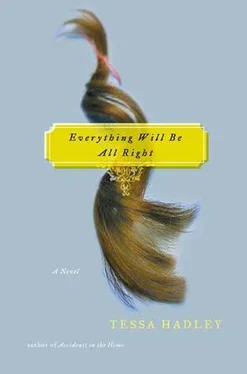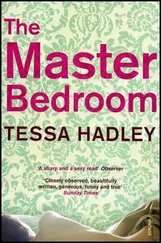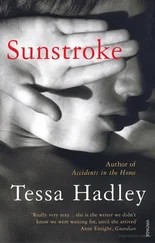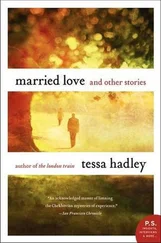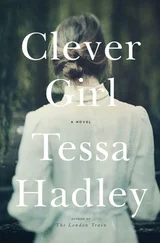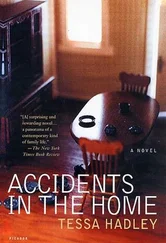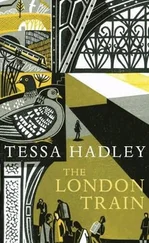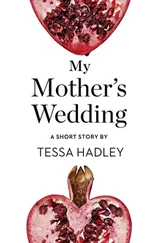Tessa Hadley - Everything Will Be All Right
Здесь есть возможность читать онлайн «Tessa Hadley - Everything Will Be All Right» весь текст электронной книги совершенно бесплатно (целиком полную версию без сокращений). В некоторых случаях можно слушать аудио, скачать через торрент в формате fb2 и присутствует краткое содержание. Год выпуска: 2003, Издательство: Henry Holt and Co., Жанр: Современная проза, на английском языке. Описание произведения, (предисловие) а так же отзывы посетителей доступны на портале библиотеки ЛибКат.
- Название:Everything Will Be All Right
- Автор:
- Издательство:Henry Holt and Co.
- Жанр:
- Год:2003
- ISBN:нет данных
- Рейтинг книги:4 / 5. Голосов: 1
-
Избранное:Добавить в избранное
- Отзывы:
-
Ваша оценка:
- 80
- 1
- 2
- 3
- 4
- 5
Everything Will Be All Right: краткое содержание, описание и аннотация
Предлагаем к чтению аннотацию, описание, краткое содержание или предисловие (зависит от того, что написал сам автор книги «Everything Will Be All Right»). Если вы не нашли необходимую информацию о книге — напишите в комментариях, мы постараемся отыскать её.
explores the tangled history of one family and the disasters, hopes, compromises, and ambitions of successive generations.
Everything Will Be All Right — читать онлайн бесплатно полную книгу (весь текст) целиком
Ниже представлен текст книги, разбитый по страницам. Система сохранения места последней прочитанной страницы, позволяет с удобством читать онлайн бесплатно книгу «Everything Will Be All Right», без необходимости каждый раз заново искать на чём Вы остановились. Поставьте закладку, и сможете в любой момент перейти на страницу, на которой закончили чтение.
Интервал:
Закладка:
Everything Ray Deare did made Joyce sure he was a genius. She listened to him in order to learn about life as well as painting. She had never heard anyone say the things he said. He said that art was play and that play was the truth of life, more real than work, duty, learning. He said he was ashamed of the dullness of obedient easel art, schooled and tamed. He said that sex was the true revolutionary act of play, and sex had to be put back into painting. Painting and sculpture were the only forms capable of keeping faith with the truth of the body. (Joyce surreptitiously glanced at Iris when Ray talked about sex, wondering whether she would give away any sign of their intimate life. Iris’s wide gaze at her husband never faltered; she didn’t even smile.) He said that an artist had to be an outsider in his own society in order to be any good, that art had to welcome every intimation that came out of the dark. He said the 1946 exhibition of Picasso at the V and A had changed his idea of art as violently and immediately as a collision with a charging bull, and anyone who thought Picasso had wasted his talent was an idiot without eyes. Or balls. He didn’t use quite these words in class, of course, but afterward, in the Gardenia or the jazz club.
He was often the noisiest and most extravagant in the crowd, and even when he was putting forward his serious view of things he waved his hands around and jumped out of his chair in such a way that you knew he was aware that there was something comical and exaggerated in his performance. He didn’t always say sensible or serious things. Sometimes you could tell he took a position merely for the sake of arguing it: that illustrations in women’s magazines should be forbidden by law or that the art market should be nationalized. When she first visited him and Iris in the flat, Joyce was disappointed. Ray seemed gloomy and was mostly silent, or he spoke with Iris about ordinary things Joyce had hardly expected him to know about: sandwich pickle they’d run out of, a shirt that needed ironing, or some fuse wire he wanted her to buy. (Joyce thought it might be for artistic purposes, but no, he just needed to repair a fuse.) She soon came to feel the thrill, though, of touching up against this tender material underside to his mysterious artist’s life. Anyway, it was a good job that Ray ignored her and left her and Iris alone to chatter. The idea of his asking her directly what she thought about anything made her hands clammy.
Ray’s paintings frightened her too. They were mostly paintings of people (this was what the college was known for; anyone who wanted to paint abstracts went to the Slade or St. Martin’s). They were nudes or portraits of friends; occasionally they were practice studies of fruit or flowers, or a bit of broken wall on a bomb site with weeds growing out of it. The subjects were elongated, squeezed, their faces hollowed, the eyes dark pits; his palette was muddy, browns and olive greens and creams, with a red he seemed to use to show energy (Iris explained this). Often there was red on the nipples of the nudes or between their legs. In the paintings of men friends a red light often hovered around the head like the tension of thought. There were a number of paintings of Iris, unmistakable despite the distortion because of the slanting lines of her face, like a bird, and the long ponytail: some nudes, some heads, one of her reading a book, one that seemed to be of her painting, splodges of jewel-like color squeezed on her opened hand as if it were a palette.
Whenever she found herself alone with one of his nudes, Joyce stared greedily at his treatment of the breasts, the belly, the mound of pubic hair; the swirling thick brushstrokes made the flesh into a rich bitter pudding, pawed and stretched the female shape into an exposing, arousing ugliness, with breasts slopped liquidly sideways or hanging loosely. She could see they were beautiful. The heaped-on thick pinks and creams and greens were a representation of how these bodies were pleasuring and powerful. Yet she felt a frisson of fear, as well as exhilaration, at the idea that her flesh might ever be stripped and seen like this. This picture of femaleness fought hard, in her idea of herself, with a different picture she clung to: the one derived from magazines and films, of flesh safely contained inside its flawless powdered skin, suggested by shadows under clinging clothes, contoured and lyrical and hidden.
* * *
The hours Joyce spent drawing in the long life room made her very happy. The room was austere and dilapidated, lit by tall windows on its northwest side, with off-white walls and bare floorboards sanded smooth by the caretaker, Mr. Bassett, with his sawdust and broom. You could draw from the plaster casts of Greek and Renaissance sculptures and bronzes that stood around, or from the skeleton who hung in her little sentry box at one end of the room, or you could draw from the live models, usually Mrs. Carey or Miss Alfred, who undressed in their “cupboard” and were kept warm with electric panel heaters in winter. Nothing must be allowed to move or change while you drew, even when everyone took a break: chalk marks were made for where the model’s chair and her feet and elbows went; you made marks for your own position, too, and for the “donkey,” the trestle where you rested your drawing board.
In the breaks the students smoked and leaned out of the windows overlooking the busy shopping street; or they warmed themselves against the fat old radiators. The models wrapped themselves in their kimonos. Some of them were thin and destitute-looking, brought in “off the streets,” as Pete Smith said: he called them casualties of the postwar austerity. Others were confident and extraordinary. Jean Alfred, who figured in so many drawings and paintings by the students and the teachers at the college, was said to have Gypsy blood in her; she was tall with a big square mouth and slanting cheekbones. She dated some of the best students and was rumored to be carrying on an affair with one of the older lecturers, as well as having a Gypsy boyfriend of her own. Her mother worked as a cleaner at the college in the evenings; they lived together in Churchtown, which was seedy and glamorously rough.
Joyce’s drawing improved. She learned to spend two and a half hours on an ear and a bit of neck, connecting them with the background, getting them right. She entered into a sort of trance as she worked, absorbed in seeing and translating, shocked if the teacher interrupted to show her something or if anyone new came pushing into the room past the thick black burlap curtain that hung inside the door to shut out sound and light and curious passersby. She did understand, though, that drawing was supposed to be a preparation for something else. It seemed a great problem that she didn’t really have any subject she urgently needed to paint. Some of the others were so sure already: Stefan Jeremy with his sooty cityscapes, Yoyo Myers with his weird bug-eyed portraits, Mary Anderson with her studies of theaters and circuses.
It felt as if this problem of her lack of a subject was all tangled up with something incomplete as yet in Joyce’s life with the crowd. She wasn’t clear what role she was supposed to play with them. They partly adopted her as a little pet, small and tidy and obliging and good fun, always ready with her admiration for other people’s work. They called her Ginger, although her hair wasn’t really ginger but a pale golden red. Yoyo took a handful of it and sifted through, sighing over it, despairing of ever being able to paint it because there were so many different colors: white and gold and auburn and strawberry. In fact, his painting of her head, with his characteristic staring bug eyes, won him the student prize that year and was the first painting he ever sold.
Joyce had been to bed with Yoyo and with a couple of the others too. (“Shagged,” the men called it, but the girls never said that. The word was hopelessly mixed up in Joyce’s mind with dirty old tobacco and the sailors who had muttered things down at the docks.) As soon as she started college she had set about ridding herself of her inexperience; the night she came home after her first time (they were still living in the old house then), she searched her face in her dressing-table mirror for signs of a new womanly allure. Her deflowering had not been in the least the bloody and momentous thing she had expected from her novel reading. So this was what people really wanted of one another; this act of playful childlike gratifications was the grown-up secret hidden under so much stuffy dullness! Everyone at college was going to bed with everyone else. At the beginning of the second year when they were queuing to reregister, Lenny Barnes pretended to start up an extra line and stood at the head of it, calling out, “Anyone queue here who’s still a virgin!”
Читать дальшеИнтервал:
Закладка:
Похожие книги на «Everything Will Be All Right»
Представляем Вашему вниманию похожие книги на «Everything Will Be All Right» списком для выбора. Мы отобрали схожую по названию и смыслу литературу в надежде предоставить читателям больше вариантов отыскать новые, интересные, ещё непрочитанные произведения.
Обсуждение, отзывы о книге «Everything Will Be All Right» и просто собственные мнения читателей. Оставьте ваши комментарии, напишите, что Вы думаете о произведении, его смысле или главных героях. Укажите что конкретно понравилось, а что нет, и почему Вы так считаете.
